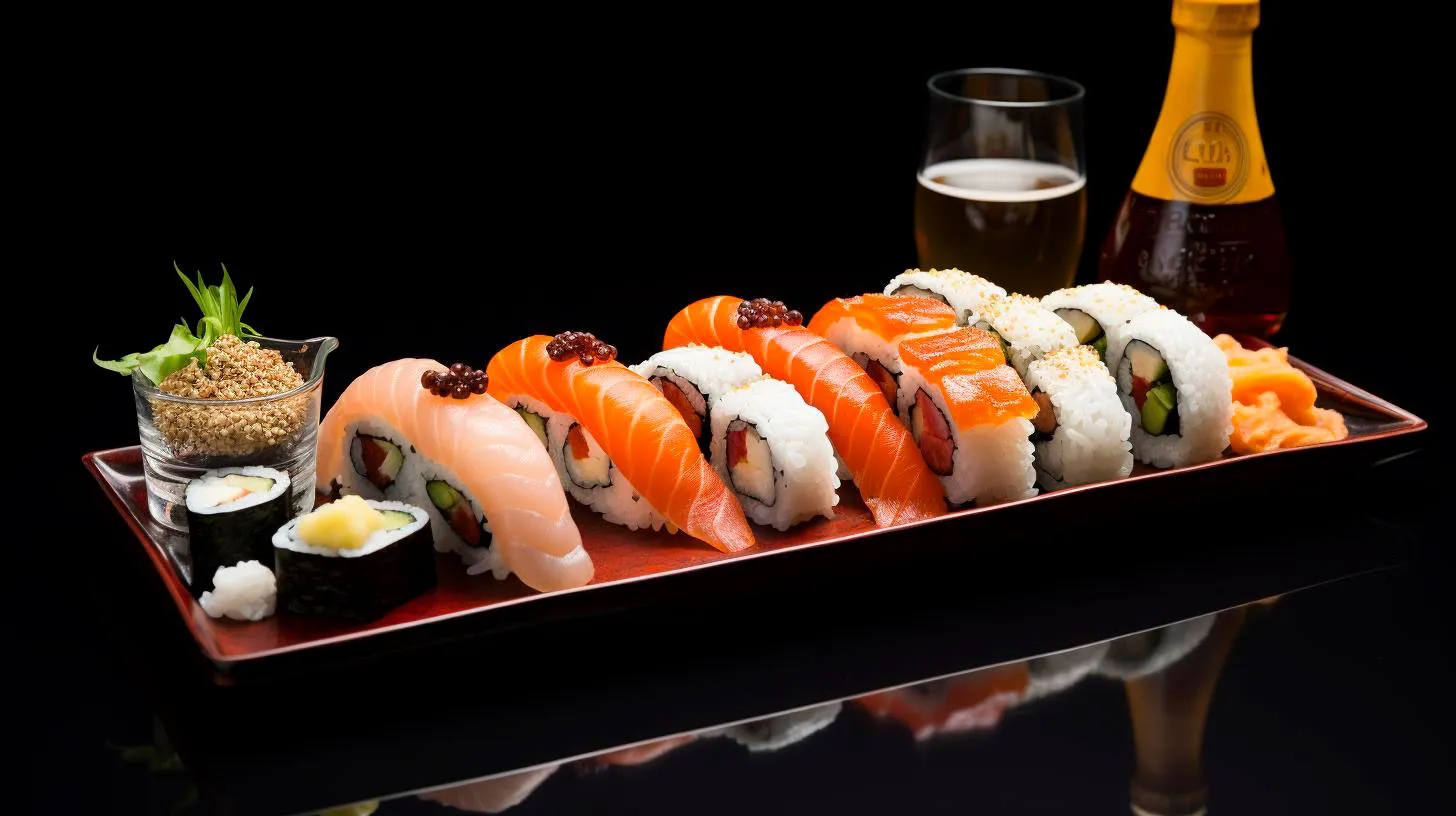Strategies for Selecting the Best Fish for Sushi at Your Local Market
However, with the right strategies in place, you can confidently choose the most suitable fish for your sushi rolls. In this article, we will delve into some effective strategies and essential tips that will help you make the best choice.
The Importance of Freshness in Sushi Fish
Freshness is paramount when it comes to selecting fish for sushi. Consuming sushi made with fresh fish not only enhances the flavor but also ensures that you are not exposed to potential health risks associated with consuming raw fish. To ensure you pick the freshest fish available, consider these strategies:
- Choose high-quality fish markets: Opt for well-known fish markets that specialize in seafood. These markets are more likely to have a better selection of fresh and sushi-grade fish.
- Observe fish selection practices: Pay attention to how the fish is handled and stored at the market. Look for clean and well-maintained display cases with fish stored on ice or refrigeration units to ensure proper freshness.
- Build a relationship with fishmongers: Developing a rapport with the people behind the counter can be beneficial. They can guide you in selecting the best fish options and even provide information on the fish’s origin, catch methods, and quality.
- Check for texture and smell: Fresh fish should have firm flesh and a mild, clean oceanic smell. Avoid fish that appears dull, has an off-putting odor, or has a slimy texture.
Sustainable Fishing Practices
Ensuring that the fish you consume are sustainably caught is an essential consideration for environmentally conscious consumers. By selecting fish caught using sustainable fishing practices, you support the preservation of marine ecosystems. Follow these tips to choose fish that align with sustainable practices:
- Research sustainable fishing methods: Educate yourself about sustainable fishing practices and regulations. Look for certifications such as the Marine Stewardship Council (MSC) that indicate the fish is sourced sustainably.
- Consult seafood guides: Several respected organizations provide seafood guides that outline the sustainability of various fish species. These guides often categorize fish based on their health and environmental impact, helping you make informed choices.
- Opt for local and seasonal fish: Choosing locally sourced fish helps reduce the carbon footprint associated with transporting seafood long distances. Additionally, selecting fish that are in-season ensures their abundance and supports the natural reproductive cycle.
Popular Fish Species for Sushi
When it comes to sushi, certain fish species have become popular due to their taste, texture, and availability. Consider these popular options:
- Maguro (Bluefin Tuna): Known for its rich flavor and fatty texture, maguro is a highly sought-after fish for sushi. Opt for sustainable options such as yellowfin or albacore tuna.
- Hamachi (Yellowtail): Yellowtail offers a delicate, buttery taste that is highly desirable in sushi. Look for responsibly farmed or wild-caught options.
- Sake (Salmon): Salmon is a classic choice for sushi, loved for its rich flavor and vibrant color. Choose wild-caught salmon for the best taste and sustainability.
- Ebi (Shrimp): Shrimp is a popular sushi ingredient, offering a sweet and delicate taste. Look for sustainably farmed or wild-caught shrimp to support sustainable practices.
Key Takeaways
Selecting the best fish for sushi at your local market requires a combination of knowledge and observation. Keep these key takeaways in mind to ensure a satisfying sushi experience:
- Freshness is crucial: Opt for high-quality fish markets and assess the fish’s texture and smell to determine freshness.
- Support sustainable fishing practices: Learn about sustainable fishing methods, consult seafood guides, and choose local and seasonal fish whenever possible.
- Popular fish species for sushi: Consider popular options like maguro, hamachi, sake, and ebi, choosing sustainable alternatives where available.
- Build relationships with fishmongers: Cultivating a good rapport with your local fishmongers can provide valuable insights and recommendations for the best sushi fish options.
By following these strategies, you can confidently select the best fish for sushi, ensuring a delectable and sustainable dining experience. Remember, fresh and high-quality fish is the foundation of memorable sushi!
Understanding the Different Varieties of Sushi-Grade Fish
When it comes to sushi-grade fish, there are several varieties to explore. In this article, we will delve into the different types of sushi-grade fish, their characteristics, and key considerations when selecting them for your sushi.
1. Yellowfin Tuna (Maguro)
Yellowfin tuna, also known as maguro in Japanese, is one of the most popular sushi-grade fish varieties. It is known for its deep red color and tender texture. Yellowfin tuna is widely used in sushi because of its mild flavor and firm, meat-like quality. It is often served as sashimi or in nigiri sushi. Key takeaways:
- Rich, deep red color
- Mild flavor with a meat-like texture
- Best suited for sashimi and nigiri sushi
2. Bluefin Tuna (Hon-Maguro)
Bluefin tuna, or hon-maguro, is considered a luxury sushi-grade fish. It has a high fat content, resulting in a rich, buttery flavor and a melt-in-your-mouth texture. Bluefin tuna is highly valued for its quality and is typically used in high-end sushi establishments. However, due to overfishing concerns, sustainable sourcing is crucial to ensure the long-term availability of this species. Key takeaways:
- High fat content, resulting in a rich, buttery flavor
- Melt-in-your-mouth texture
- Consider sustainable sourcing for long-term availability
3. Salmon (Sake)
Salmon, or sake in Japanese, is a staple in both traditional and fusion-style sushi. It is characterized by its beautiful orange color and rich flavor. Salmon can be served raw or lightly seared, and its creamy texture pairs well with various sushi ingredients. It is a popular choice among sushi lovers, and its versatility makes it an excellent option for both beginners and seasoned sushi connoisseurs. Key takeaways:
- Beautiful orange color and rich flavor
- Creamy texture that complements various ingredients
- Can be served raw or lightly seared
4. Halibut (Hirame)
Halibut, known as hirame in Japanese, is a delicate white fish with a mild, slightly sweet flavor. It has a firm texture and is considered an excellent choice for sushi. Halibut is often served as sashimi or in sushi rolls, and its subtle taste allows it to blend well with other ingredients. Key takeaways:
- Delicate white fish with a mild, slightly sweet flavor
- Firm texture, perfect for sushi
- Best served as sashimi or in sushi rolls
5. Yellowtail (Hamachi)
Yellowtail, or hamachi, is a flavorful fish commonly used in sushi. It has a buttery texture and a delicate, sweet taste. Yellowtail can be enjoyed raw or lightly seared, and its distinct flavor adds depth to various sushi preparations. It is highly versatile and pairs well with different seasonings and sauces. Key takeaways:
- Flavorful fish with a buttery texture
- Delicate, sweet taste
- Can be enjoyed raw or lightly seared
- Pairs well with a variety of seasonings and sauces
Key Considerations for Selecting Sushi-Grade Fish
When selecting sushi-grade fish, there are a few important factors to keep in mind:
- Freshness: Choose fish that is fresh and sourced from reputable suppliers. Look for bright eyes, shiny skin, and a pleasant scent.
- Sustainability: Consider the environmental impact and choose fish that is sourced sustainably to support the preservation of our oceans.
- Handling and Storage: Ensure that the fish is handled and stored properly to maintain its quality and safety.
Understanding the different varieties of sushi-grade fish allows you to appreciate the art and precision behind sushi-making. Whether it’s the rich flavor of yellowfin tuna, the buttery texture of bluefin tuna, the versatility of salmon, the delicacy of halibut, or the unique taste of yellowtail, each variety brings its own charm to the sushi experience. By considering freshness, sustainability, and proper handling, you can create a delightful sushi feast using the finest sushi-grade fish available.
Essential Tips for Evaluating the Freshness of Fish
So, how can you ensure that the fish you buy is fresh and safe to eat? In this article, we will discuss essential tips for evaluating the freshness of fish, helping you make informed decisions when purchasing fish for your next meal.
Why Freshness Matters
Freshness is key when it comes to fish. Not only does it affect the taste and aroma, but it also determines the nutritional value and safety of the fish. Fresh fish is the best choice if you want to enjoy its delicate flavor, moist texture, and the optimal levels of omega-3 fatty acids. On the other hand, spoiled fish can lead to foodborne illnesses due to the growth of harmful bacteria and toxins.
Evaluating Freshness
To ensure you are buying the freshest fish possible, keep the following tips in mind:
1. Examine the Eyes
The eyes of a fish can reveal a lot about its freshness. Fresh fish will have clear, bright, and bulging eyes. On the other hand, cloudy and sunken eyes are signs of a fish that has started to deteriorate.
2. Check the Gills
The gills of a fresh fish should be bright red or pink. They should also be moist and free from any slime. Avoid fish with gills that appear grayish or brownish, as this indicates spoilage.
3. Smell the Fish
A fish should only have a mild oceanic smell. If it has a strong, ammonia-like odor or smells “fishy,” it is likely not fresh. Fresh fish should not have any foul or pungent odors.
4. Assess the Texture
The texture of the fish can also provide clues about its freshness. Ideally, fresh fish should have tight and shiny scales that cling to the skin. The flesh should be firm, elastic, and bounce back when touched.
5. Be Mindful of the Color
The color of the fish’s flesh can vary depending on the species. However, it should generally be vibrant, translucent, and have a slight sheen. Avoid fish with dull or discolored flesh, as this may indicate spoilage.
6. Consider the Smell after Cooking
If you are still unsure about the freshness of the fish, you can also evaluate its smell after cooking. Fresh fish will have a pleasant aroma and retain its delicate flavor. Spoiled fish, on the other hand, will have an overpowering and unpleasant smell.
Key Takeaways
- Fresh fish is essential for both taste and safety reasons.
- Examining the eyes, gills, smell, texture, and color of the fish can help determine its freshness.
- Fish with clear, bright, and bulging eyes is usually fresh.
- Check for bright red or pink gills to ensure freshness.
- Fresh fish should have a mild oceanic smell, not a strong “fishy” odor.
- The texture should be firm, elastic, and the scales tightly adhered to the skin.
- Translucent and vibrant flesh is a sign of freshness.
- After cooking, fresh fish will have a pleasant aroma and retain its delicate flavor.
By following these tips, you can confidently evaluate the freshness of the fish before purchasing it. Remember, fresh fish not only guarantees a delightful culinary experience but also ensures you are consuming a healthy and nutritious meal. Enjoy your next seafood feast!
Identifying Signs of Poor Quality Fish in Sushi
As a consumer, it’s essential to be able to identify signs of poor quality fish in sushi to ensure a satisfying dining experience. In this article, we will explore some key indicators that can help you determine if the sushi you’re about to enjoy is made with fresh and top-notch fish.
1. Fish Smell
One of the first signs of poor quality fish in sushi is a strong, unpleasant odor. Fresh fish used in sushi should have a mild, subtle aroma that is not overpowering. If you detect a strong fishy smell or any ammonia-like scent, it’s likely an indication that the fish is not fresh. Fresh fish should have a clean and oceanic smell, which is indicative of its quality and taste.
2. Texture of the Fish
The texture of the fish can also give you valuable insights into its quality. High-quality fish used in sushi should have a firm and tender texture. When you take a bite, it should melt in your mouth and not be rubbery or chewy. Fish that feels mushy or lacks the desired consistency might be a sign of poor quality or improper handling and storage of the fish.
3. Appearance and Color
Another important aspect to observe is the visual appearance and color of the fish. Fresh fish used in sushi should have vibrant, natural colors. If the fish looks dull, discolored, or has any browning or dark spots, it’s likely that it is not fresh and may even be spoiled. Additionally, pay attention to the sushi rice. The rice should have a shine and not be overly sticky or dry.
4. Country of Origin
Knowing the country of origin of the fish can provide valuable information about its quality. Some countries have stricter regulations and standards when it comes to handling and harvesting seafood. For example, fish imported from Japan, known for its high-quality seafood, may be more reliable than fish from countries with less stringent regulations. Checking the country of origin can give you an idea of the fish’s quality and safety.
The Key Takeaways
- Pay attention to the smell of the fish – it should not have a strong odor or smell of ammonia.
- The texture of the fish should be firm, tender, and should melt in your mouth.
- Fresh fish should have vibrant colors and should not have any browning or dark spots.
- Consider the country of origin of the fish to gauge its quality and safety.
By keeping these indicators in mind, you can become more proficient at identifying signs of poor quality fish in sushi and make informed decisions about where to enjoy this delectable cuisine. Remember, don’t be afraid to ask questions about the fish’s sourcing and freshness at your local sushi restaurant. Your taste buds will thank you for seeking out the best quality sushi available.


